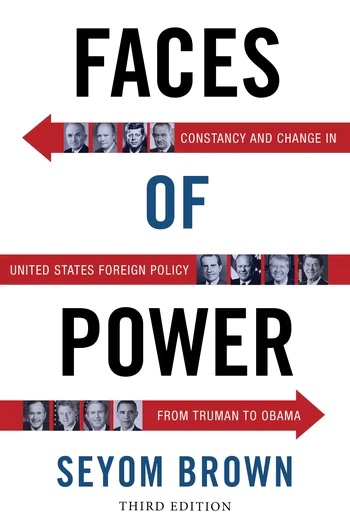Seyom Brown's authoritative account of U.S. foreign policy from the end of the Second World War to the present challenges common assumptions about American presidents and their struggle with power and purpose. Brown shows Truman to be more anguished than he publicly revealed about the use of the atomic bomb; Eisenhower and George W. Bush to be more immersed in the details of policy formulation and implementation than generally believed; Reagan to be more invested in changing his worldview while in office than any previous president; and Obama to have modeled his military exit from Iraq and Afghanistan more closely to Nixon and Kissinger's exit strategy from Vietnam than he would like to admit. Brown's analyses of Obama's policies for countering terrorist threats at home and abroad, dealing with unprecedented upheavals in the Middle East, preventing the proliferation of nuclear weapons, and containing new territorial expansion by China and Russia reinforce the book's "constancy and change" theme, which shows that serving the interests of the most powerful country in the world transforms the Oval Office's occupant more than its occupant can transform the world.
Praise for previous editions:
"Systematic and informative... [Brown] has a gift for clear analysis that makes his book a useful contribution to the Cold War literature."—The Journal of American History
"Comprehensive and clear... thorough without ever becoming dull, providing detailed analysis of decisions while never neglecting the environment within which they are made."—International Affairs
"An excellent reference for those interested in United States foreign policy.... Well-written and well-researched, it is appropriate for use in both undergraduate and graduate courses."—International Journal
"An analysis with difference—an important difference. Seyom Brown discusses United States policy from the perspective of how decision makers in the United States viewed their adversaries and the alternatives as those decision makers saw them.... Well worth the effort of a careful reading."—American Political Science Review
- Table of Contents
- Preface
- Introduction: Constancy and Change Since WWII
- Part I. The Truman Administration
- 1. The Shattering of Expectations
- 2. Implementing Containment
- Part II. The Eisenhower Era
- 3. A New Look for Less Expensive Power
- 4. Waging Peace: The Eisenhower Face
- 5. Crises and Complications
- Part III. The Kennedy-Johnson Years
- 6. Enhancing the Arsenal of Power
- 7. The Third World as a Primary Arena of Competition
- 8. Kennedy’s Cuban Crises
- 9. Berlin Again
- 10. The Vietnam Quagmire
- Part IV. Statecraft Under Nixon and Ford
- 11. Avoiding Humiliation in Indochina
- 12. The Insufficiency of Military Containment
- 13. The Middle East and the Reassertion of American Competence Abroad
- 14. The Anachronism of Conservative Realpolitik
- Part V. The Carter Period
- 15. The Many Faces of Jimmy Carter
- 16. The Fusion of Realism and Idealism
- 17. The Camp David Accords: Carter’s Finest Hour
- 18. Iran and Afghanistan: Carter’s Struggles to Salvage Containment
- Part VI. The Reagan Era—Realism or Romanticism?
- 19. High Purpose and Grand Strategy
- 20. The Tension Between Foreign and Domestic Imperatives
- 21. Middle East Complexities, 1981–1989: The Arab-Israeli Conflict, Terrorism, and Arms for Hostages
- 22. Contradictions in Latin America
- 23. The Reagan-Gorbachev Symbiosis
- Part VII. Prudential Statecraft with George Herbert Walker Bush
- 24. Presiding Over the End of the Cold War
- 25. The Resort to Military Power
- 26. The New World Order
- Part VIII. Clinton’s Globalism
- 27. From Domestic Politician to Geopolitician
- 28. Opportunities and Frustrations in the Middle East
- 29. Leaving Somalia and Leaving Rwanda Alone
- 30. Getting Tough with Saddam and Osama
- 31. Into Haiti and the Balkans: The Responsibility to Protect
- Part IX. The Freedom Agenda of George W. Bush
- 32. Neoconservatives Seize the Day
- 33. 9/11, the War on Terror, and a New Strategic Doctrine
- 34. From Containment to Forcible Regime Change: Afghanistan and Iraq
- 35. National Security and Civil Liberties
- Part X. Obama’s Universalism Versus a Still-Fragmented World
- 36. Engaging the World
- 37. Ending Two Wars
- 38. Counterterrorism and Human Rights
- 39. Ambivalence in Dealing with Upheavals in the Arab World
- Epilogue
- Notes
- Index

